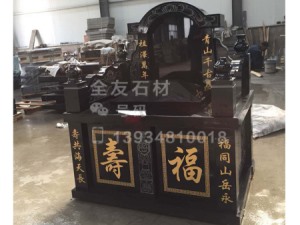Company Name: Hunyuan County Quanyou Stone Processing Factory
Contact: Mr. Wang
Tel: 13754914913
Company fixed line: 0352-8425006
Company fax: 0352-8425088
Company mailbox: 935913883@qq.com
Company address: Industrial Park, Hunyuan County, Datong City, Shanxi Province
How do small tombstones inherit traditional Chinese tombstone culture?
Since ancient times, the Chinese have attached great importance to tombstone culture, regard tombstones as a cultural carrier to commemorate the deceased, and send remembrance and grief. Therefore, tombstones not only contain many carvings and decorations, which signify ominous wishes, but also many Exquisite Feng Shui appearance.
As usual, with the trend of funeral reform, tombstones tend to be miniaturized and localized. Traditional tombstones and luxury tombstones with typical Chinese traditional tombstone cultural characteristics have become inconsistent with the new funeral regulations. Small tombstones have gradually emerged and become The mainstream of the tombstone market. Then, how to inherit the traditional Chinese tombstone culture and show the common artistic value of small tombstones has become a problem that has to be considered.
The standard size of small tombstones is limited to an area of 0.5 square meters and a height of 0.8 meters, which is very different from the size of previous tombstones. It is a big challenge to display the cultural characteristics of traditional Chinese tombstones within such a small size limit. .Chinese traditional tombstone culture is closely related to the Confucian concept of "filial piety", which is a manifestation of the concept of life and death that "death is like life". The shape and carving of the tombstone are carefully crafted to decorate the resting place of the soul of the deceased , to express "filial piety" and respect for the deceased.
Create an artistic appearance with cultural connotations
Due to the size limitation of small tombstones, the structure of tombstones with traditional Chinese characteristics, such as railings, monument pillars, and monument tops, has to be simplified. It is composed of two parts: the base and the main monument. Such a simple appearance structure wants to inherit some of the traditional Chinese tombstone culture. Characteristic, you have to get rid of the fixed outline of 44 squares and increase the artistic appearance with more personality and creativity.
For example, it is possible to separate traditional Chinese elements to design the outline of the tombstone, and integrate traditional Chinese elements such as the sun, moon, auspicious clouds, pine cranes, lotus, etc.
Carved decorative patterns with deep meaning
The size of small tombstones is reduced, and the carving area is also greatly reduced. When designing the carving patterns of small tombstones, it is necessary to minimize the carving and decoration without cultural significance, and design carving patterns with in-depth cultural meanings, so that small tombstones can be given greater cultural art. Value. For example, traditional Chinese elements with rich meanings such as dragon and phoenix, pine and crane, plum orchid, chrysanthemum and bamboo, lotus and deer, etc., can be decorated on the main monument and base of small tombstones, which can decorate the tombstone and express the memory of tombstone culture.
Some monuments are embossed patterns of pine cranes and auspicious clouds, which means that the deceased "goes on a crane to the fairyland" and the soul returns to the fairyland, which is a wonderful blessing to the soul of the deceased after death. "Goodness" represents the ominous blessing of the deceased's kindness and kindness during his lifetime, good deeds, and evil retribution after death. While making the tombstone more beautiful and beautiful, it also shows its common artistic and cultural value.
It can be seen that small tombstones can integrate and inherit traditional Chinese elements in appearance and carving, thereby increasing the artistic and cultural value of tombstones and inheriting traditional Chinese tombstone culture.

Related News
- Cemetery tombstone manufacturers: What are the disadvantages of using paraffin to maintain stone
- Black granite is gradually becoming popular
- What is the existence of Zhangqiu Black Tombstone?
- Quanyou Stone introduces you to the advantages of black tombstones
- What are the ways to prevent Chinese black tombstones from turning white?
- Looking for traditional tombstone carvers to pay tribute to the "craftsman spirit
- How to deal with the macula on Chinese black tombstones
- Repair method for small gaps in black granite tombstones
- Cemetery tombstone manufacturers: knowledge about funeral taboos
- How to Eliminate the Influence of Salt on Chinese Black Tombstones
- How to carefully craft a meaningful traditional tombstone!
- A summary of styles of black tombstones in Shanxi
- There are several aspects of traditional tombstone lettering
- About the classification type of black granite
- The writing format of traditional tombstone inscriptions
- Which two aspects reflect the traditional Chinese tombstone culture?
- What does the tombstone mean?
- Characteristics of black granite stone used in Shanxi black tombstones
- The shape of traditional tombstones is deeply influenced by traditional culture
- How to properly maintain Chinese black tombstones



